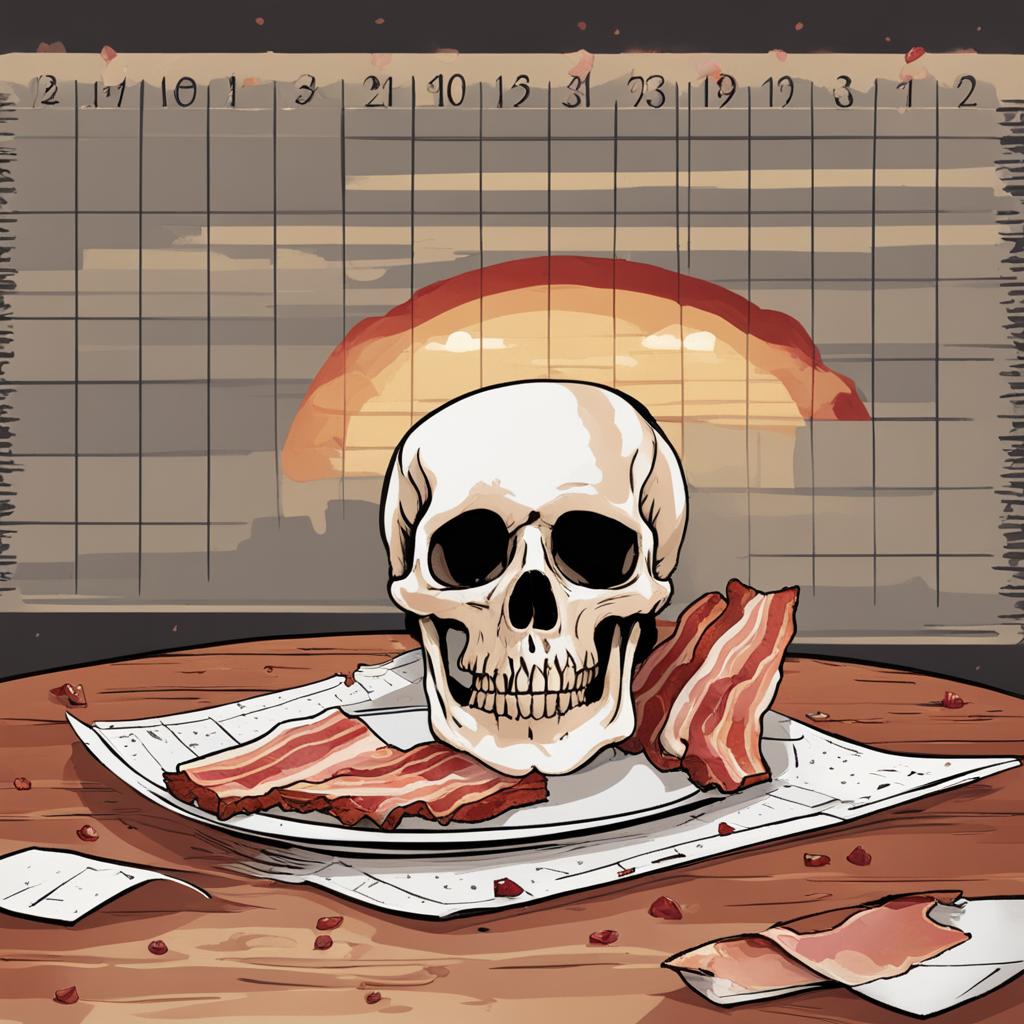Bacon is a beloved food item that many people enjoy. However, like any perishable food, bacon can go bad. It’s important to be able to recognize the signs of spoilage in order to ensure that you’re consuming bacon that is safe and delicious. In this article, I will guide you through the various indicators that can help you determine if your bacon has gone bad.
From checking the packaging for a date to inspecting the smell, texture, color, and presence of mold on the bacon, there are multiple factors to consider. By paying attention to these signs, you can confidently make the decision whether to discard or consume your bacon.
Key Takeaways:
- Checking the date on the packaging is a quick way to assess the freshness of bacon.
- Inspecting the packaging for any damage is important to prevent spoilage.
- A sour or sulfuric smell indicates that the bacon has gone bad.
- If the bacon feels slimy to the touch, it is a clear sign of spoilage.
- Discoloration, such as green, gray, or brown meat, indicates the presence of bacteria and/or fungi.
Checking the Date
When it comes to determining the freshness of bacon, checking the date on the packaging is a good place to start. Many bacon packages have a sell-by or use-by date printed on them. The sell-by date is intended for the store to know when the bacon should be sold, while the use-by date indicates when the bacon is expected to reach its peak quality.
It is generally advised to use bacon within one week after the sell-by date or to discard it if the use-by date has passed. This is because the quality of the bacon may deteriorate over time, affecting its taste and texture. While bacon can still be safe to consume after these dates, it may not provide the best eating experience.
Checking the date is a simple yet effective way to ensure that your bacon is fresh and of high quality. By paying attention to these dates, you can enjoy your bacon at its best.
| Sell-By Date | Use-By Date |
|---|---|
| Indicates when the store should sell the bacon | Represents the peak quality period for the bacon |
| Use bacon within one week after this date | Discard bacon if this date has passed |
Note: The sell-by date and use-by date may vary depending on the brand and packaging of the bacon. Always refer to the specific date provided on the package for accurate information.
Inspecting the Packaging
Proper packaging is crucial in maintaining the freshness and quality of bacon. When buying bacon, it is essential to inspect the packaging for any signs of damage or compromise. A damaged package can allow air and bacteria to enter, leading to spoilage and potential health risks. Here are some key points to consider when inspecting the packaging:
- Check for any visible tears, punctures, or holes in the packaging. These can create entry points for bacteria and compromise the integrity of the bacon.
- Ensure that the packaging is tightly sealed. Vacuum-sealed packaging helps to prevent exposure to air and prolong the shelf life of the bacon.
- Look for any signs of discoloration or moisture inside the package. These can be indications of spoilage.
By carefully examining the packaging, you can ensure that you are purchasing fresh and safe bacon for consumption.
Table: Common Packaging Issues
| Issue | Consequence |
|---|---|
| Torn or punctured packaging | Increased risk of bacterial contamination and spoilage |
| Loose or unsealed packaging | Exposure to air and potential loss of freshness |
| Discoloration or moisture inside the package | Possible signs of spoilage and decreased quality |
It’s important to remember that proper packaging is the first line of defense against spoilage. By ensuring the packaging is intact and free from any damage, you can maintain the quality and safety of your bacon.
Smell
One of the key indicators that bacon has gone bad is the smell. Fresh bacon should have a smoky scent that is distinct and appetizing. However, if you detect a strong rancid odor or a sour, sulfuric smell, it is a clear indication that the bacon is no longer safe to consume. This unpleasant odor is usually caused by the growth of bacteria, yeast, or fungi on the bacon, which can pose health risks if ingested.
When assessing the smell of bacon, trust your nose. If it doesn’t smell right, it’s best to err on the side of caution and discard the bacon. Consuming spoiled bacon could lead to foodborne illnesses and unpleasant symptoms like upset stomach, diarrhea, and fever, among other health complications.
Remember, proper food safety practices are crucial. If you notice an off-putting smell coming from your bacon, it’s better to be safe than sorry and find an alternative for your meal.
| Sign | Indication |
|---|---|
| Rancid or sour odor | Bacon has gone bad |
| Smoky scent | Bacon is fresh |
| Sulfuric smell | Bacon is spoiled |
Texture
When it comes to determining if bacon has gone bad, the texture is a key indicator. Fresh bacon should have a soft and firm texture. However, if you notice that the bacon feels slimy to the touch, it is a clear indication that it has spoiled. The sliminess is caused by certain types of bacteria breaking down the meat, and consuming such bacon can lead to foodborne illness.
In addition to the slimy texture, spoiled bacon may also feel overly sticky or tacky. This change in texture is a result of the breakdown of fats and proteins in the bacon. It is important to trust your sense of touch and discard any bacon that feels slimy or sticky, as consuming it could pose a health risk.
Remember, when it comes to bacon texture, fresh and firm is good, while slimy or sticky is a clear sign of spoilage. Trust your senses and err on the side of caution when it comes to consuming bacon with an unusual texture.
Table: Comparing Fresh Bacon Texture to Spoiled Bacon Texture
| Attributes | Fresh Bacon | Spoiled Bacon |
|---|---|---|
| Texture | Soft and firm | Slimy, sticky, or tacky |
| Causes | Freshness, proper storage | Bacterial breakdown of fats and proteins |
| Risk | No risk | Potential for foodborne illness |
| Action | Safe to consume | Discard immediately |
Color

One of the key indicators of whether bacon has gone bad is its color. Normally, bacon has a pinkish-red color with marbling of white fat. However, if you notice that the bacon has turned green, gray, or brown, it is a clear sign of spoilage. These color changes indicate the presence of bacteria and/or fungi on the bacon, which can be harmful to consume.
Discoloration in bacon occurs due to the growth of microorganisms, such as Pseudomonas, which can lead to foodborne illnesses. It is important to note that these pathogens may not be visible to the naked eye, even if the discoloration is only present in a small area. Therefore, it is recommended to discard the entire piece of bacon to avoid any potential health risks.
By inspecting the color of bacon before cooking or consuming it, you can determine its freshness and ensure food safety. If the bacon has any unusual color, it is best to err on the side of caution and discard it. It is important to prioritize your health and well-being when it comes to consuming food, and avoiding spoiled bacon is an essential part of that.
Table: Bacon Color Indicators
| Color | Indication |
|---|---|
| Pinkish-red with marbled white fat | Fresh and safe to consume |
| Green, gray, or brown | Sign of bacterial or fungal growth, indicating spoilage |
Mold
In addition to checking the date, inspecting the packaging, and observing the bacon’s smell, texture, and color, it’s important to keep an eye out for mold growth. Mold on bacon is a clear sign that it has gone bad and should not be consumed.
Mold appears as visible patches of fuzzy or powdery growth and is caused by the presence of fungi. Even if the mold is only present in a small area, it is best to discard the entire piece of bacon. This is because there may be invisible bacteria and fungi throughout the bacon that can pose a health risk.
To prevent mold growth, properly store bacon in the refrigerator or freezer at the appropriate temperature. When storing opened bacon, wrap it in aluminum foil or place it in a zip-top bag to help maintain its freshness. Storing bacon in an airtight container can also help prevent mold formation.
| Mold on Bacon | Action |
|---|---|
| Mold is visible on a small area | Discard the entire piece of bacon |
| Mold is not visible, but there is a strong rancid smell | Discard the bacon |
| No mold or strong rancid smell | Bacon is safe to consume |
Remember, consuming bacon with mold can lead to foodborne illnesses. It’s crucial to ensure the bacon you consume is fresh and free from any signs of spoilage. When in doubt, it’s always better to err on the side of caution and discard bacon that shows any signs of mold or other spoilage indicators.
Shelf Life After Opening
Once you open a package of bacon, its shelf life diminishes. Proper storage and handling are crucial to maintain its freshness and prevent any health risks. Here’s what you need to know:
- Uncooked bacon: If you have opened uncooked bacon, it should be consumed within one week if stored in the refrigerator. The exposure to air and bacteria starts the spoilage process immediately, so it’s important to use it as soon as possible.
- Cooked bacon: When it comes to cooked bacon, it can last four to five days in the refrigerator if stored properly. Make sure to store it in an airtight container immediately after use to maintain its freshness.
To give you a better idea of the shelf life of bacon after opening, take a look at the table below:
| Type of Bacon | Refrigerator Shelf Life |
|---|---|
| Uncooked, opened bacon | Up to one week |
| Cooked, opened bacon | Four to five days |

Remember, these timeframes are general guidelines and can vary depending on factors such as temperature and storage conditions. Always use your best judgment and rely on the signs of spoilage we discussed earlier, such as smell, texture, color, and the presence of mold.
Tips for Proper Storage:
- For unopened bacon, store it in its original packaging or an airtight container.
- If you’ve opened the bacon, wrap it in aluminum foil or place it in a zip-top bag.
- Store cooked bacon in an airtight container to maintain its freshness.
- Make sure to keep bacon refrigerated or frozen at the appropriate temperature.
By following these storage guidelines and being mindful of the shelf life of opened bacon, you can enjoy this delicious food while ensuring food safety for you and your family.
Freezing Bacon
If you have excess bacon that you want to preserve for later use, freezing is a great option. Freezing bacon can extend its shelf life and ensure you always have some on hand. However, it’s important to follow the proper steps to ensure the best results.
Freezing Uncooked Bacon
To freeze uncooked bacon, start by dividing it into portion sizes that you typically use for your recipes. This way, you can thaw only what you need without wasting any. Wrap each portion tightly in plastic wrap or aluminum foil to prevent freezer burn. Then, place the wrapped portions in a freezer-safe bag or airtight container to protect them further.
When freezing uncooked, unopened bacon, it can last for up to eight months in the freezer. However, it’s important to note that the quality and flavor of bacon may start to deteriorate after prolonged freezing. So it’s best to use it within a reasonable time frame for optimal taste.
Freezing Cooked Bacon
If you have leftover cooked bacon, you can also freeze it for later use. Allow the cooked bacon to cool completely before freezing. Similar to uncooked bacon, it’s advisable to portion out the cooked bacon and wrap each portion tightly in plastic wrap or aluminum foil. Then, place the portions in a freezer-safe bag or airtight container.
Cooked bacon can be frozen for up to one month. However, keep in mind that the quality may diminish over time. To maintain the best flavor and texture, it’s recommended to consume the cooked bacon within a reasonable period after freezing.
| Bacon Type | Freezer Shelf Life |
|---|---|
| Uncooked, unopened bacon | Up to 8 months |
| Leftover raw bacon | Up to 6 months |
| Cooked bacon | Up to 1 month |
Remember to label each package with the date of freezing to keep track of when it should be used. Properly stored frozen bacon will retain its quality and can be a convenient option for quick meals or when you’re in a pinch for time and have limited fresh options available.
“Freezing bacon can extend its shelf life and ensure you always have some on hand.”
Proper Storage
Proper storage is crucial to maintain the freshness and quality of bacon. By following a few simple guidelines, you can ensure that your bacon stays delicious and safe to eat.
Airtight Containers
One of the best ways to store bacon is in an airtight container. This helps to keep out air and moisture, which can cause the bacon to spoil more quickly. Make sure the container is tightly sealed to maintain freshness.
For unopened packages of bacon, you can store them in their original packaging or transfer them to an airtight container. If you have opened a package of bacon, wrap the remaining slices in aluminum foil or place them in a zip-top bag before storing them in an airtight container.
Refrigerator or Freezer
Bacon should be stored in the refrigerator or freezer to prevent bacterial growth. The ideal temperature for refrigerated storage is between 33°F and 40°F (-0.5°C and 4°C) to maintain freshness.
If you plan to use the bacon within a week, storing it in the refrigerator is sufficient. However, if you want to extend its shelf life, you can freeze bacon. Freezing can help preserve the quality and flavor of bacon for a longer period.
When freezing bacon, it’s important to wrap it tightly in plastic wrap or place it in a freezer bag to prevent freezer burn. Be sure to label the package with the date to keep track of how long it has been frozen.
Proper Handling
In addition to proper storage, it’s important to handle bacon safely to prevent cross-contamination. Always wash your hands before and after handling raw bacon to avoid spreading bacteria.
Clean any surfaces or utensils that come into contact with raw bacon to prevent the spread of harmful bacteria. Use hot, soapy water and sanitize cutting boards, knives, and countertops thoroughly.
By following these storage and handling guidelines, you can ensure that your bacon stays fresh, flavorful, and safe to eat.
How Long Cooked Bacon Lasts
When it comes to the shelf life of cooked bacon, proper storage is key. Storing cooked bacon in an airtight container is essential to keep it fresh for as long as possible. If stored properly, cooked bacon can last four to five days in the refrigerator.
However, if you want to extend the shelf life of your cooked bacon even further, freezing is an option. Cooked bacon can be frozen for up to one month, but it’s important to note that the quality and flavor may diminish over time.
Whether you choose to store your cooked bacon in the refrigerator or the freezer, make sure to transfer it to an airtight container immediately after use. Proper storage will help maintain the freshness and overall quality of the bacon, ensuring that you can enjoy it for longer.
Consuming Bad Bacon
When it comes to bacon, consuming bad or spoiled bacon can have serious consequences for your health. Bad bacon may be contaminated with harmful bacteria such as salmonella, E. coli, and staphylococcus, which can cause food poisoning. These bacteria are heat-resistant, meaning that even cooking the bacon at high temperatures may not eliminate them.
Symptoms of food poisoning from bad bacon can range from mild gastrointestinal discomfort to more severe health complications. Common symptoms include upset stomach, diarrhea, nausea, vomiting, abdominal pain, and fever. In some cases, food poisoning can lead to dehydration, weakness, and even hospitalization.
To avoid the risks associated with consuming bad bacon, it is crucial to be able to identify the signs of spoilage. This includes checking the packaging for any damage, inspecting the color, texture, and smell of the bacon, as well as watching out for the presence of mold. If any of these signs are present, it is best to err on the side of caution and discard the bacon to avoid potential health risks.
Table: Common Symptoms of Food Poisoning from Bad Bacon
| Symptom | Description |
|---|---|
| Upset stomach | Feeling of discomfort or uneasiness in the abdomen |
| Diarrhea | Loose, watery stools occurring more frequently than usual |
| Nausea | Feeling of sickness or queasiness in the stomach |
| Vomiting | Forceful expulsion of stomach contents through the mouth |
| Abdominal pain | Discomfort or cramping in the stomach or abdominal area |
| Fever | Elevated body temperature above the normal range |
It is important to prioritize safe food handling practices and proper storage to prevent the growth of harmful bacteria on bacon and other perishable foods. By being vigilant and knowledgeable about the signs of bad bacon, you can protect yourself and your loved ones from foodborne illnesses and enjoy this delicious treat safely.
Conclusion
After reviewing the various signs of spoilage in bacon, it is clear that ensuring food safety is essential. By checking the date, inspecting the packaging, and observing the smell, texture, color, and presence of mold, you can determine whether your bacon has gone bad. Proper storage and handling of bacon also play a crucial role in preventing foodborne illnesses.
Remember, if your bacon shows any signs of spoilage, it is best to discard it to avoid potential health risks. Consuming bad bacon can lead to food poisoning, as it may contain harmful bacteria like salmonella, E. coli, and staphylococcus. These bacteria are resistant to heat and cannot be eliminated through cooking.
By following these guidelines and being vigilant about the freshness of your bacon, you can ensure that you and your family enjoy this delicious food item without any concerns. Prioritizing food safety is always a smart choice, and it starts with being able to identify the signs of spoilage in bacon.
FAQ
How can I tell if bacon has gone bad?
There are several signs to look out for to determine if bacon has gone bad. These include checking the packaging for a date, inspecting the packaging for any damage, and observing the smell, texture, color, and presence of mold on the bacon.
How do I check the date on bacon?
Many bacon packages have a sell-by or use-by date. The sell-by date is for the store to know when to sell the bacon, while the use-by date is when the bacon reaches peak quality. It is advised to use bacon within one week after the sell-by date or to discard it if the use-by date has passed.
What should I look for when inspecting the packaging of bacon?
Proper packaging is essential for maintaining the freshness of bacon. If the packaging is damaged or not vacuum-sealed, it could allow air and bacteria to enter, leading to spoilage. Before purchasing bacon, ensure that the package is intact and free from any signs of damage.
How should bacon smell if it is fresh?
Fresh bacon should have a smoky scent. Any sour or sulfuric odor indicates that the bacon has gone bad. This odor is caused by the growth of bacteria, yeast, or fungi on the bacon. It is important to pay attention to the smell and avoid consuming bacon with a strong rancid smell.
What texture should fresh bacon have?
Fresh bacon should have a soft and firm texture. If the bacon feels slimy to the touch, it is a clear indication that it has spoiled. The sliminess is caused by certain types of bacteria breaking down the meat, and consuming such bacon can lead to foodborne illness.
What color should fresh bacon be?
Normally, bacon has pinkish-red meat marbled with white fat. If the bacon has turned green, gray, or brown, it indicates the presence of bacteria and/or fungi. Discoloration is a sign of spoilage, and it is recommended to discard the bacon if it has changed color.
How can I identify if there is mold on bacon?
Mold growth on bacon is a clear sign that it has gone bad. Mold is visible to the naked eye and indicates the presence of fungi. Even if the mold is only present in a small area, it is best to discard the entire piece of bacon, as there may be invisible bacteria and fungi throughout.
How long can I keep opened bacon?
Once a package of bacon is opened, its shelf life decreases. Opened uncooked bacon should be consumed within one week if stored in the refrigerator. Cooked bacon, when stored properly, can last four to five days in the refrigerator.
Can I freeze bacon to extend its shelf life?
Freezing bacon can extend its shelf life. Uncooked, unopened bacon can be frozen for up to eight months, while leftover raw bacon can be frozen for up to six months. Cooked bacon can be frozen for up to one month. However, the quality and flavor of bacon may deteriorate after prolonged freezing.
How should I properly store bacon?
Proper storage is crucial to maintain the freshness of bacon. Unopened bacon should be stored in its original package or an airtight container. Opened bacon can be wrapped in aluminum foil or placed in a zip-top bag. Cooked bacon should also be stored in an airtight container. Storing bacon in the refrigerator or freezer at the appropriate temperature is essential.
How long does cooked bacon last?
Cooked bacon can last four to five days in the refrigerator when stored properly. It is important to store cooked bacon in an airtight container immediately after use. Freezing cooked bacon can extend its shelf life to about one month, but the quality may diminish over time.
What are the risks of consuming bad bacon?
Consuming spoiled bacon can lead to foodborne illness. Bad bacon may contain harmful bacteria such as salmonella, E. coli, and staphylococcus, which are heat-resistant and cannot be eliminated by cooking. Symptoms of food poisoning from bad bacon can include upset stomach, diarrhea, fever, and more serious health complications.
How can I ensure food safety when it comes to bacon?
It is important to be able to identify the signs of spoilage in bacon to ensure food safety. Checking the date, inspecting the packaging, observing the smell, texture, color, and presence of mold are all crucial in determining whether bacon has gone bad. Proper storage and proper handling of bacon can help prevent foodborne illnesses. When in doubt, it is best to discard bacon that shows signs of spoilage to avoid potential health risks.
Source Links
- https://www.colemannatural.com/blog/how-to-tell-if-bacon-has-gone-bad-4-easy-signs/
- https://www.atablefullofjoy.com/how-to-tell-if-bacon-is-bad/
- https://www.allrecipes.com/article/how-long-does-bacon-last/
Related Recipes:
 Spotting Bad Lemons: What to Look For
Spotting Bad Lemons: What to Look For
 Identifying a Bad Whole Turkey
Identifying a Bad Whole Turkey
 Signs Your Almond Milk Has Spoiled
Signs Your Almond Milk Has Spoiled
 Egg Freshness Test: Good or Bad?
Egg Freshness Test: Good or Bad?
 Can You Eat Expired Butter? What You Need to Know
Can You Eat Expired Butter? What You Need to Know
 How Long Can Yogurt Sit Out? Guidelines and Safety
How Long Can Yogurt Sit Out? Guidelines and Safety
 Does Almond Milk Go Bad? How to Tell and Storage Tips.
Does Almond Milk Go Bad? How to Tell and Storage Tips.
 Recognizing When a Tomato is Past Its Prime
Recognizing When a Tomato is Past Its Prime








